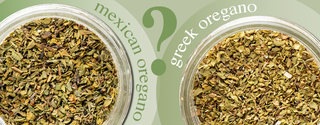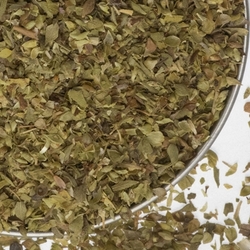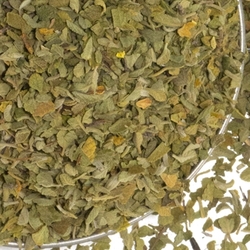The Oregano Throwdown: Mediterranean vs Mexican
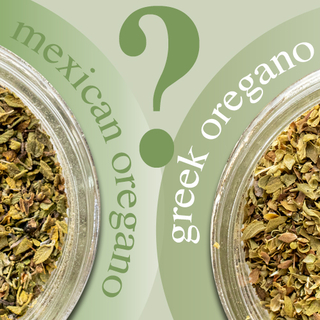
Mexican Oregano vs. Oregano
Despite their similar names, Greek Oregano and Mexican Oregano are the products of entirely different plants. Both are bitter herbs and share some flavor-defining essential oils. In addition, they are both peppery with a green, herbaceous aroma. However, Greek Oregano originated along the sunny shores of the Mediterranean and is part of the mint family. Mexican Oregano emerged in Mexico and Central America and is related to citrusy plants like lemon verbena.
What is Greek Oregano?
Greek Oregano, Origanum vulgare, is the herb commonly thought of in the US as Mediterranean oregano or just oregano. It is part of the mint family Lamiaceae and other aromatic herbs like basil, rosemary, thyme, and lavender. Greek Oregano is piney, peppery, and sharp, with an earthy base and menthol and lemon undertones.
Oregano emerged in southern Europe’s temperate regions and is a traditional. It boasts its Greek origins in its name; oros means “mountain” and ganos means “brightness” or “joy”. Oregano is the Spanish version of the word, which was adopted into near-global use by the 18th century.
Popularly thought of as the “pizza herb”, Greek Oregano did not gain a solid foothold in the US culinary scene until the end of World War II. At that time, Hector Boiardi—later of Chef Boyardee’s fame—was commissioned to cook rations for soldiers overseas. As these soldiers ate his canned spaghetti, they came to enjoy oregano’s sassy flavor. Once the war ended and the soldiers came home, they wanted things flavored with their new favorite herb. Oregano sales climbed more than 5200 percent between 1948 and 19561; once oregano entered the inner circle of staple kitchen spices, it never left.
What is Mexican Oregano?
Mexican Oregano, Lippia graveolens, is a relative newcomer to US palates. This Mexican herb is strong and pungent and, like its Greek counterpart, delivers bitter and peppery flavors. Because of this fundamental resemblance, it was given the Spanish name “oregano” even though it was used long before the Spanish came to Mexico. Mexican Oregano is verdant and grassy, with an anise-like taste topped by lively citrus and lime. It is also called oregano cimarron or hierba dulce—wild oregano or sweet herb, respectively. It lends balance to woodsy Mexican spices like allspice and cinnamon and heightens the citrus flavors that are so prevalent in Mexican dishes.
This herb originated throughout Mexico and Central America. It is considered a native plant as far north as southern Texas; it edges into Nicaragua on the south. It is a member of the Verbenaceae family, along with the fruity herb lemon verbena. This plant family is mainly comprised of decorative flowers with potent aromas, like lantana, and tropical woods like teak and mangrove.
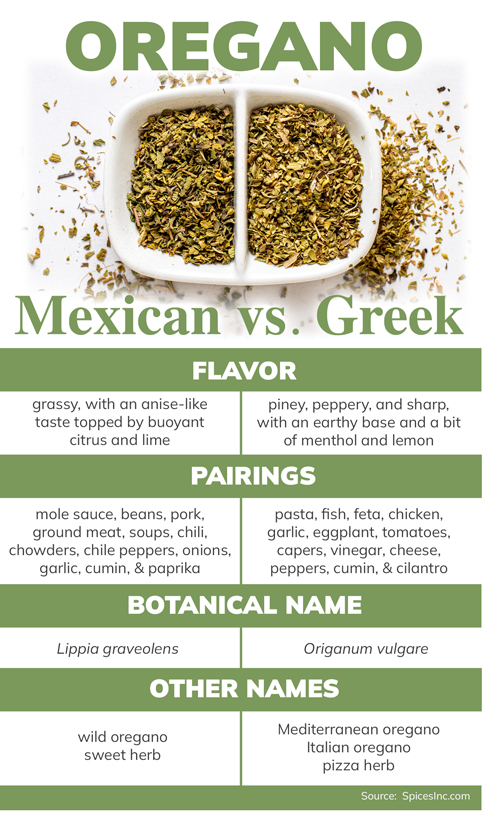 Which Oregano is Best for Cooking?
Which Oregano is Best for Cooking?
Mexican and Greek Oregano are excellent herbs to cook, delivering terrific flavor. Because of the sturdy nature of these herbs, their tastes will not fade during cooking, as can happen with delicate, leafy herbs. Both kinds of oregano should be added at the beginning of cooking, so flavors can fully infuse throughout a dish.
The warm, snappy flavors of Greek Oregano go well with the bright flavors of Mediterranean food, adding herbaceousness to salty fish and feta. It goes wonderfully with garlic, eggplant, peppers, cumin, cilantro, tomatoes, capers, vinegar, and cheese. It has even been used to flavor beer and cider.
Use Greek Oregano in a sunny, succulent dish like Provencal Chicken. It elevates the flavor of sun-dried tomatoes and bell peppers. And it’s accompanied by an impressive array of related herbs so that you can explore this minty family's many nuances in one aromatic serving.
Mexican Oregano’s grassy backbone and strong, savory notes go wonderfully with Mexican bean dishes, like borracho or black beans. It pairs well with chile peppers, ground meat, onions, garlic, cumin, and paprika; use this in your favorite pot of chili whenever possible. Try it in soups, chowders, or a traditional Mexican mole.
Use this herb when making a chili; we recommend you cook up a pot of White Bean and Turkey Chili and embrace Mexican Oregano’s grassy flavor against the backdrop of beans and chiles. Or cook a leisurely pot of Adovada, a braised pork dish from New Mexico made with spicy chiles and onions. It is fall-apart tender and peppery; citrusy Mexican Oregano punches up its flavor.
You can use Greek Oregano as a substitute for Mexican Oregano. Greek Oregano is a bit more mellow than Mexican, but since they share a peppery base of flavor and some lemony notes, it can approximate the flavor. Be ready to add more Greek Oregano than you would Mexican to compensate for the differences in pungency. Marjoram has a slightly more citrusy top note and is often recommended as a better substitute for Mexican Oregano rather than Greek Oregano.
Mexican Oregano is not a good substitute for Greek Oregano. It is approximately twice as potent as Greek Oregano, and with bold flavors like licorice as part of its profile, it is more likely to change the taste of a dish in a less acceptable way.
How to Store
Mexican and Greek Oregano should be stored in a container with an airtight lid, in a cabinet or pantry that protects the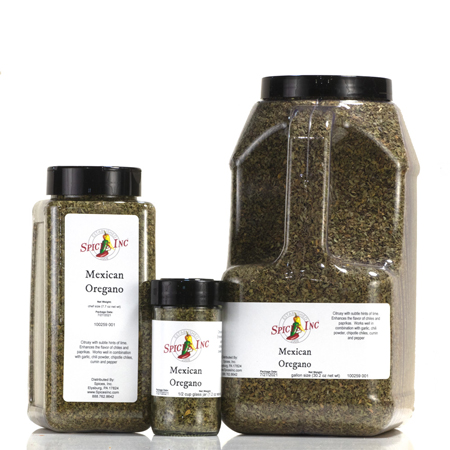 herbs from heat and direct sunlight. They should be stored along with other herbs, spices, and dried chiles in a relatively stable temperature and low humidity storage area.
herbs from heat and direct sunlight. They should be stored along with other herbs, spices, and dried chiles in a relatively stable temperature and low humidity storage area.
Keeping them away from the heat also means they should not be stored near your oven and stove. These appliances generate ambient heat when they’re in use. That radiates out and raises the temperature of the air around them. Heat and direct sunlight cause volatile oils to degrade and break down into the air around them in the jar. When oils degrade and dissipate, your herbs are rendered flavorless.
To protect them further, do not add herbs to a dish by shaking them directly over a hot, steaming pot. This can cause the herbs to absorb moisture from the steam, which leads to mold when the airtight container holding the herbs is re-sealed.
If you follow these basic steps to store Mexican and Greek Oregano, you can expect your herbs to remain viable and preserve their lively flavors for 6-12 months.
Both Mexican and Greek Oregano deliver bold flavors to dishes. Mexican Oregano is more pungent than Greek Oregano, but their peppery flavor profile is the basis for their shared name. Each herb prefers certain foods; you can use Greek Oregano with tomatoes, sweet peppers, and eggplant. Pair Mexican Oregano with chiles, beans, and ground meats. Store them somewhere cool, dark, and dry. Once you get this down, these two herbs can expand your culinary repertoire and open your kitchen to a wide world of flavor.

